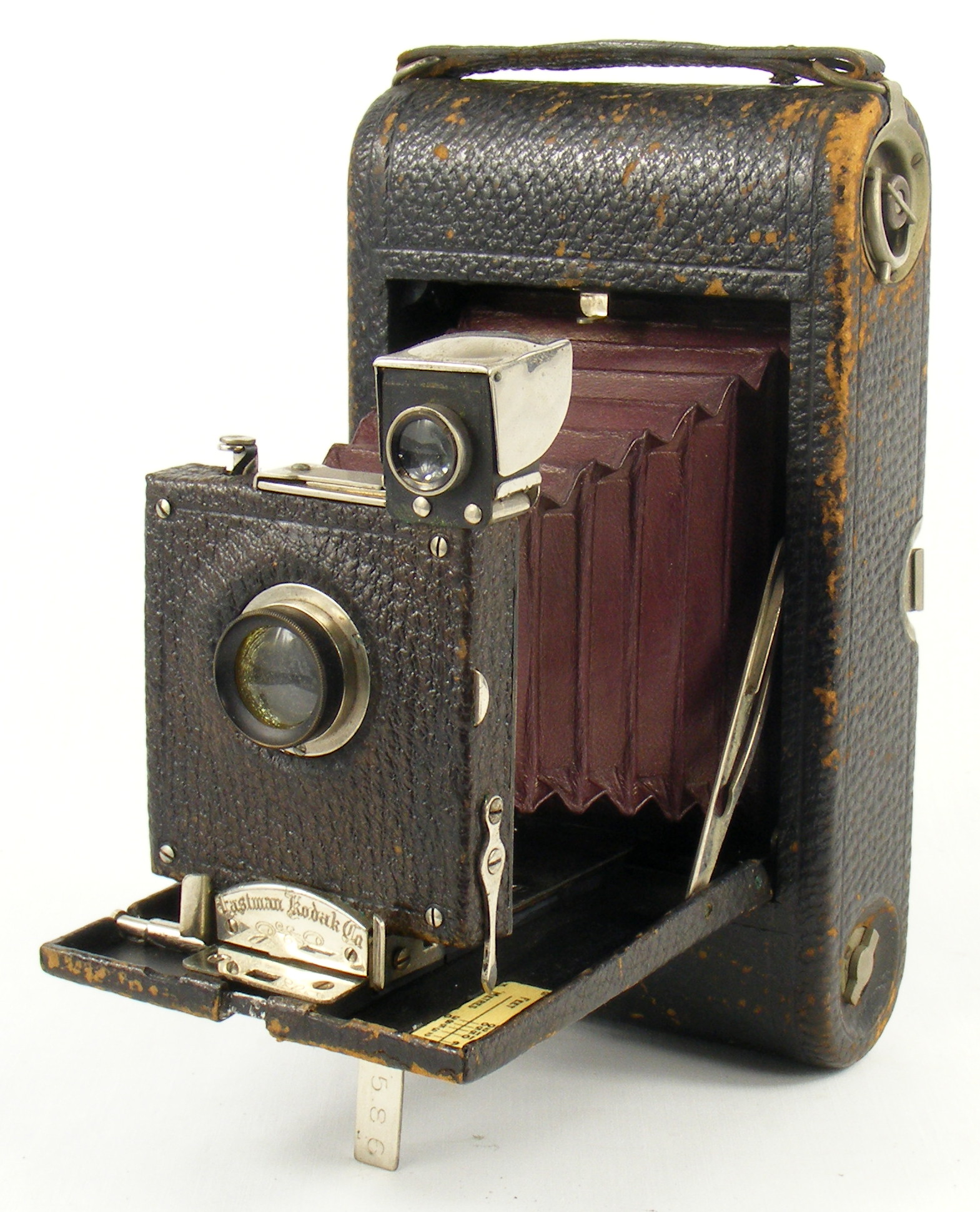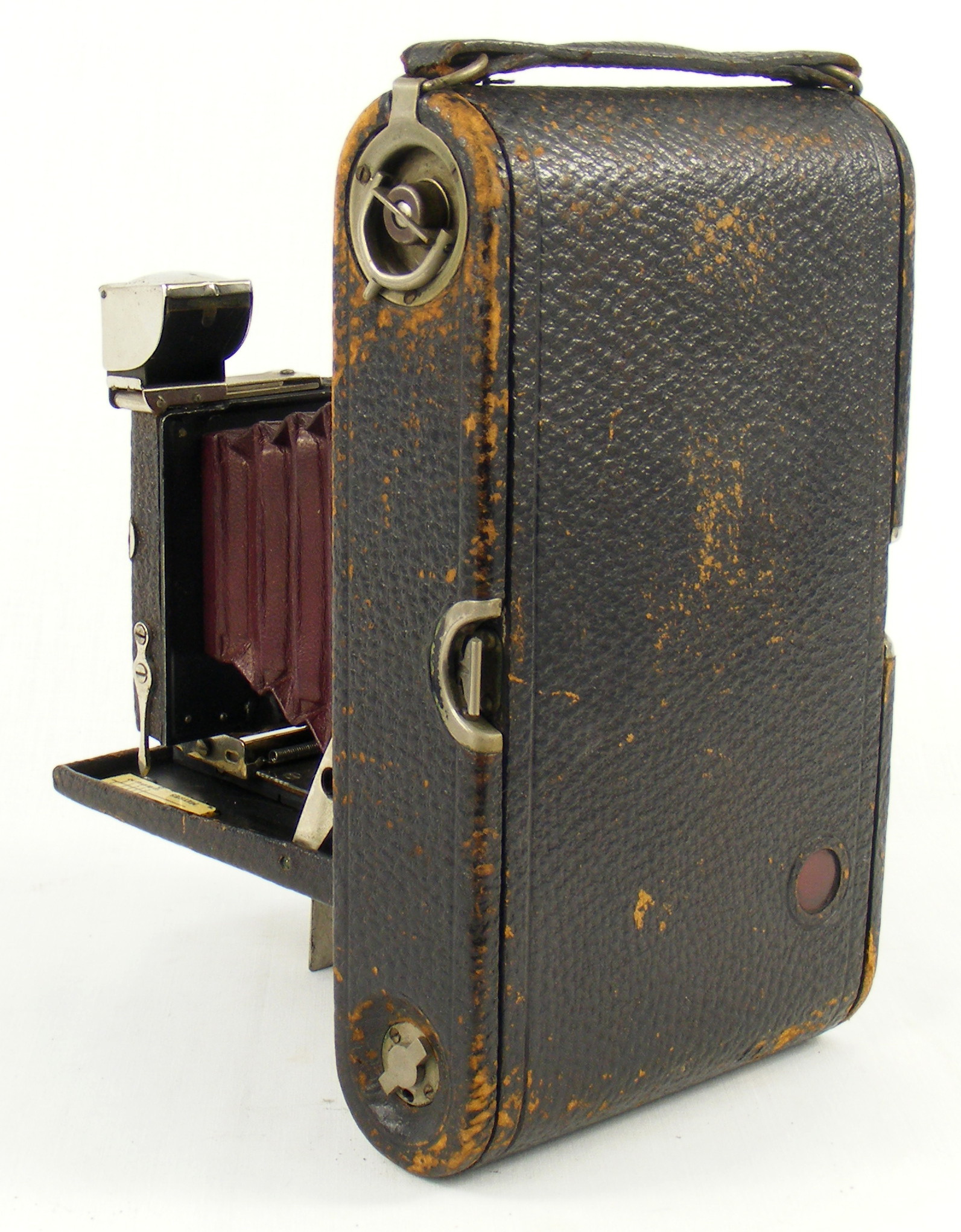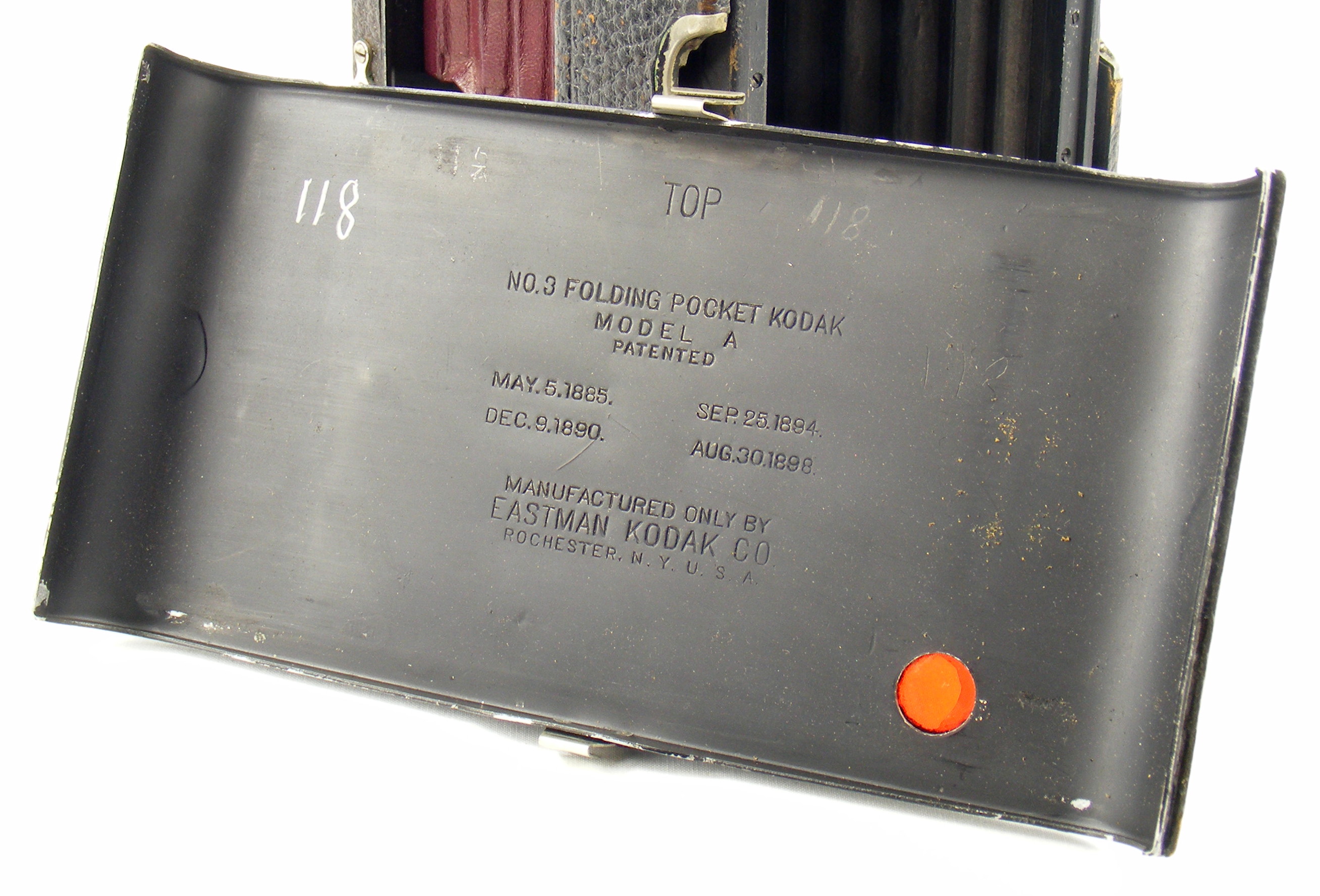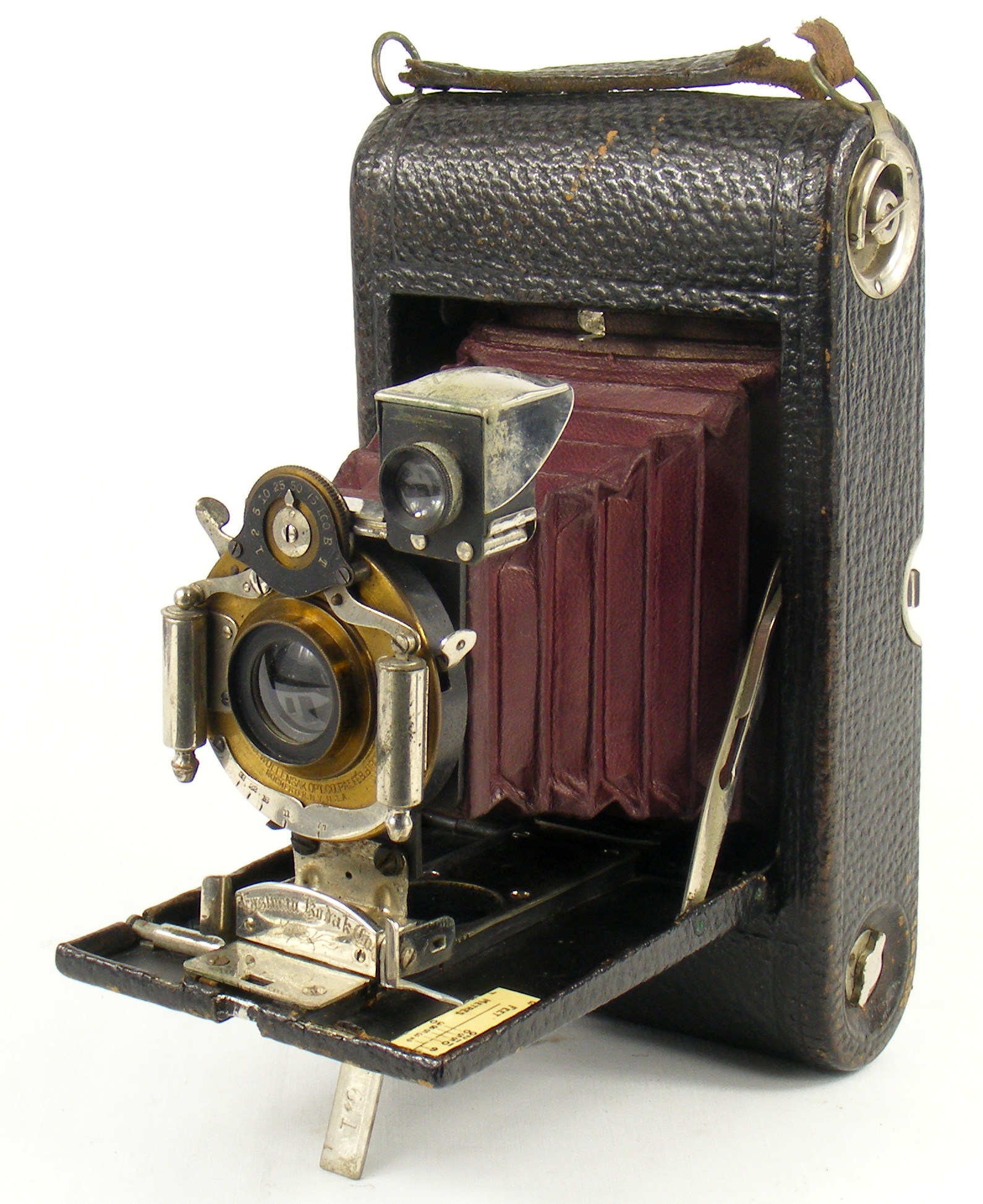No 3 Folding Pocket Kodak Camera
Eastman Kodak Company
| Name: | No 3 Folding Pocket Kodak |
| Manufacturer: | Eastman Kodak Co. |
| Country of Origin: | USA |
| Construction: | The camera is constructed as a vertical format
folding camera. Reflecting
finder. The initial model had the shutter integrated into the leather covered lens board, which then changed to a more conventional format with a separate shutter. From Model D onwards, the camera was fitted with a rising front. |
| Plate / Film Size: | 118 rollfilm (3¼" x 4¼") |
| Dimensions (w x h x l): | |
| Production Period: | 1900 - 1915 |
As with many of the Folding Pocket cameras, the No 3 Folding Pocket Kodak camera underwent a series of design changes during its production.
There were two quite distinct forms: variants of the No 3 Folding Pocket Kodak that had a rising front and those without. According to Coe [4], both variants were available concurrently from 1903, but all models were fitted with a rising front after November 1909. To complicate matters further, the serial numbers for the non rising front model started at 301, while that of the rising front model started at 101 but between 1903 and 1909 carried an "E" suffix.
Based on data published by Coe, the non-rising front form went through a model sequence of Model A, AB, C, C-2, C-3, C-4 & C-5.
The rising front form went through a model sequence of Model D, E, E-2, E-3, E-4, E-5 & F, G & H.
Within each model there are also a significant number of variations of lenses and shutters available.
| Model / Variant: | First model (non-rising front) |
| Lens: | Rapid Rectilinear |
| Shutter: | Eastman Automatic (built-in) |
| Movements: | None |
| Date of this Example: | 1900 |
| Serial Number: | Serial 14586 |
| Availability: |
|
| Inventory Number: | 121 |

Description
This is an example of the first model of the No 3 Folding Pocket Kodak (non-rising front) produced from April to October 1900. The first design change identified by Coe is a modification to the lens slide block to help protect the bellows, which was introduced from serial 14951, so this example pre-dates that change.

The features that identify an original model of the No 3 FPK are as follows:
- Square leather covered lens panel with " Eastman Kodak Co" engraved on the plate below it
- Serial number less than 14951
- The lens standard pulls out along a flat strip slide mounted on the baseboard
- The support built into the baseboard for horizontal pictures consists of a pin
- Model shown as "A" on the inside of the removable back
This example matches these parameters: the lens slide on this example is a flat strip and the baseboard support for horizontal pictures is a pin.

~ # ~ # ~
| Model / Variant: | A mystery! |
| Lens: | Bauch & Lomb Rapid Rectilinear |
| Shutter: | Rauber & Wollensak (1 - 100, B, T) |
| Movements: | None |
| Date of this Example: | 1900 |
| Serial Number: | Serial 7161 |
| Availability: |
|
| Inventory Number: | 322 |

Description
This example of the No 3 Folding Pocket Kodak is clearly an early model, but it does not obey the rules as I understand them from the available documentation.
From its serial number, this example ought to have the leather covered lens standard with built-in shutter, as #121 above. Instead it has an exposed metal lens standard with a Rauber & Wollensak shutter. However, the lens slide is a flat strip and the baseboard support for horizontal pictures is a pin.
I have had discussions about this with several other collectors. One sent me a photo of another Model A with a metal lens standard, though it has the rounded shape that was to appear as standard later, and a Unicum shutter. The standard on this example is square.
It might be that this camera was bought without a lens/shutter assembly and this was fitted for or by Cullens (the camera is marked with their name as distributor, as is the case), or perhaps the in-built shutter failed and was completely replaced? A mystery! Nonetheless a very unusual variant of the early format, which is in good order.
~ # ~ # ~
| Model / Variant: | Model D |
| Lens: | Rapid Rectilinear |
| Shutter: | FPK Automatic |
| Movements: | Rising front |
| Date of this Example: | 1903 |
| Serial Number: | 2850-E |
| Availability: |
|
| Inventory Number: | 314 |
<Photographs to be added>
Description
An example of the Model D of the No 3 Folding Pocket Kodak, the first model produced with a rising front, which is locked by clips.
This example also has a contemporary plate back making it interesting to compare with the Flushback Kodak. The scale has also been replaced with one showing positions for both plate & film, and may have been part of the kit with the back? There are no plateholders or ground glass screen.
The last patent date on the back is 1902 and it is labelled as Combination back for No 3
Folding Pocket Kodak
.
The Model D, according to Coe, was only made from June to November 1903, with quantities limited to 4,800 (serial 101-E to less than 4910-E when the Model E was introduced). This one is serial 2850-E, making it a slightly earlier model than #129. The bellows are maroon.
The bodywork on this example is in very good order, with only minor scuff marks. The handle is present and strong. The maroon bellows have faded somewhat but are intact. The lens standard was a little difficult to withdraw when first acquired - I used pencil lead to lubricate the track, which improved this greatly.
~ # ~ # ~
| Model / Variant: | Model D |
| Lens: | Rapid Rectilinear |
| Shutter: | FPK Automatic |
| Movements: | Rising front |
| Date of this Example: | 1903 |
| Serial Number: | 3477-E |
| Availability: |
|
| Inventory Number: | 129 |
<Photographs to be added>
Description
This is another example of the Model D of the No 3 Folding Pocket Kodak. This one is serial 3477-E, so slightly later in production than #314. The bodywork is in good condition, with the exception of an area on the back where the leather has lifted and has suffered some minor damage.
I have kept this duplicate in my collection because it has an interesting story associated with it.
The case has "E. R. M-W. RIFLE BRIGADE." stamped into the flap. Another bidder in the online auction subsequently contacted me to suggest that he knew who the original owner had been. The following information has been partially validated against other sources, and believe it to be broadly accurate.
"The initials on the case can only be attributed to one man Edmund Richard Meade-Waldo.
Born 11/2/1881 , educated Eton & Sandhurst. Gazetted as a 2nd/Lieu. 11/8/1900 , Lieu. 21/1/1902 , Capt. 23/3/1910 , Major 1/9/1915 , Temp. Lt Colonel 28/10/1916, retired 11/10/1922.
Served with the 3rd Battalion Rifle Brigade in India, Aden UK & Ireland 1900-13 & France 1914-15.
Battalion Major 17th Infantry Brigade 1915-16, attached to the Machine Gun Corps 1916, GSO 2 14th Division 1917, GSO 2 15th Army Corps 1917-19 & 3rd Battalion Rifle Brigade UK 1920-21. After retirement in 1936 he became a JP in Kent.
Awards for the First War, DSO 1916, 1914 Star, British War Medal & Victory Medal; mentioned in despatches three times."
Notes
For other variants of the No 3 FPK, see also the No 3 Flush-Back Kodak and the No 3 Folding Pocket Kodak DeLuxe.
![[ ]](../../images/unchecked.png)
![[x]](../../images/checked.png)